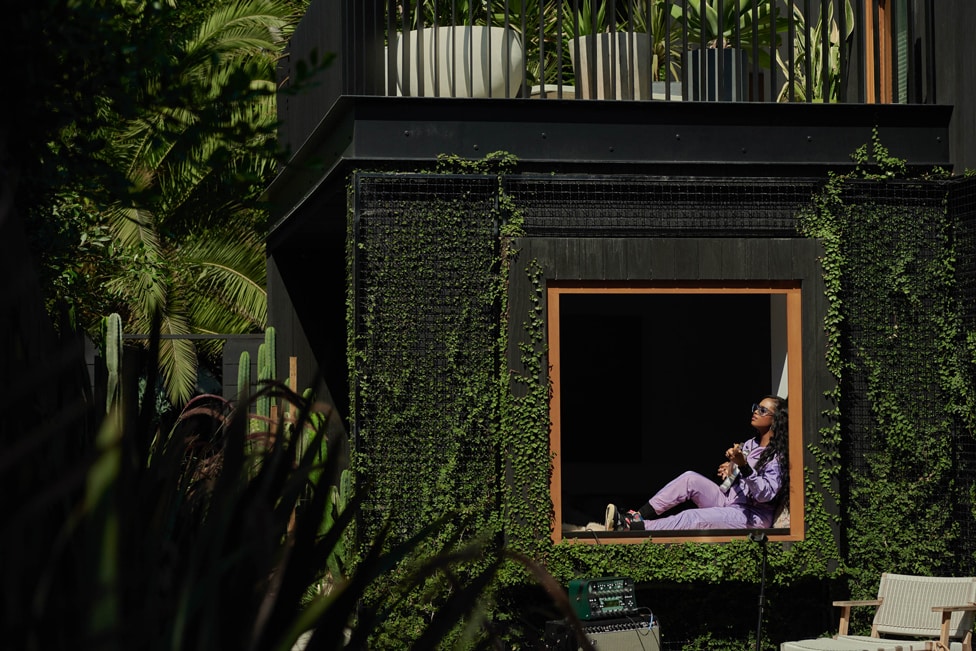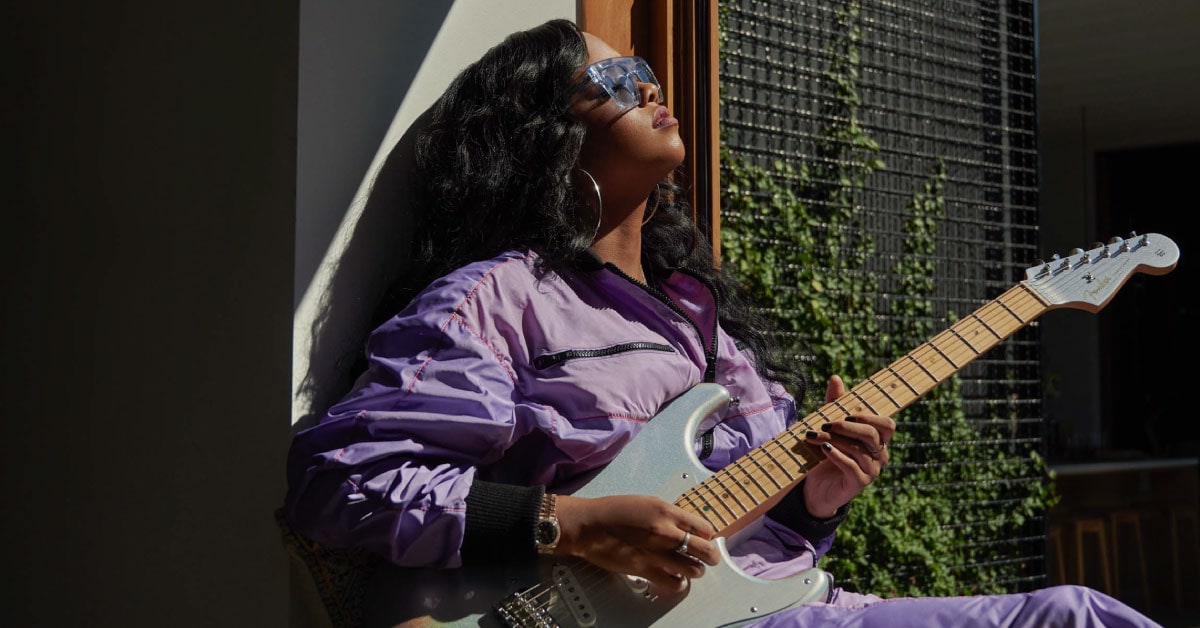When you have an artist who can sing soulful R&B while blasting off Hendrix- and Clapton-style riffs to a song she wrote, played keys and drummed on, “phenomenal” might be selling H.E.R. short. Born to an African-American father and a Filipino mother, H.E.R. blurs the lines between genres, and is making history as the first Black woman to have her own signature Strat –showcased during her highly touted SNL appearance. On the show, she performed “Damage” and “Hold On.” The latter of the two songs featured the two-time Grammy-Award winner laying down a tasty solo on her new signature Fender Stratocaster. During the following interview, H.E.R. talked about why the Strat is her guitar of choice and how it became the inspiration for her music.
You’ve got some history with the Strat. Tell us about it.
Well, since I was a little girl, music has been an outlet for me. It’s kind of been my escape. There’s always been a guitar sitting next to my bed. My dad plays guitar and he used to have this like greenish-gray Strat. And it was really big, but I would play it. When I was seven years old, he bought me a black and white Strat. It was a little smaller, and he taught me how to play the blues pentatonic scale on it. The first thing I ever learned how to play was the blues on my Strat. That was the beginning of it all. The Strat is an iconic guitar just because of the look of it. The shape of it is so iconic, and I mean, the tone, the heaviness of the Strat, I think it cuts through a lot more than a lot of other guitars. And it’s just a go-to. It’s a Strat … it’s classic.
Who are some of your favorite Strat players? Who inspired you to play?
Jimi Hendrix, Eric Clapton, Stevie Ray Vaughan, John Mayer and Prince. I remember my dad would cook breakfast for me and there would be a video of Prince and Lenny Kravitz jamming. And it made me want to be a rock star. I just loved being around the energy of it. My mom’s Filipino and Filipinos love karaoke. So, it was a lot of karaoke in the house, and there was a lot of James Brown, and a bunch of old guys playing bass and drums and jamming out all the time. I was just surrounded by it. That's how I started playing. It was like, “I want to do that. What is that sound? What is this distorted guitar? I need to find that. I want to master that.” I met Carlos Santana super randomly when I was like nine years old. He had all this knowledge. I was just so inspired by the sound and how he made the guitar sing. As a vocalist, I just felt like it could enhance what I already do with my instrument here.
What are some of your songs that are best suited for a Strat?
Songs that I really love to play on my Strat would definitely be “Hard Place.” A lot of the solo stuff songs like, “Sometimes.” Yeah, those are probably my two favorite songs to play on the Strat just because of the tone. The sound of it is just perfect for those songs.
This is Fender's first signature guitar by a Black female artist. Can you talk about the significance of that and why representation is so important?
I've looked up to a lot of guitar players, but there haven’t been many Black female artists who have been in this position and have been able to represent Black women. The goal is to inspire with this guitar. And representation is really important. I know a lot of little girls out there who may want to pick up the guitar, but they don't have anybody to look up to, or they don't have anyone that's doing it that makes them feel like, “I can do it, too.” That's the idea of this guitar and even in just what I do, and the message that I carry with me. The legacy I want to leave is just to inspire and pass the torch on to the next girls who want to kill it on the guitar, who want to shred. You know, I've been underestimated a lot when I pick up the guitar, but then when I start playing, it's like, “Oh, okay.” So, you know I want to make people feel like they can do it, too.
How did you first describe this guitar to Fender—what were those first conversations like?
So, it’s interesting how I came to this design. Number one was after playing my acrylic one on the Grammys; people always want to touch it. They're always like, “Wow, that's so cool. I've never seen a guitar that looks like that and kind of has this glow about it when the light hits it.” I do this thing on my nails a lot where it’s chrome, iridescent, and it's like holographic. I said to them, “It would be really dope to have a guitar with that same kind of paint and that iridescence, and that glow … the rainbow vibe when the light hits it. It’s very subtle. But if you see it, it's like whoa. It's like a unicorn in guitar form to me. I just wanted something really unique, something that really stands out, but subtle like me. It’s very smooth, and we have those noiseless pickups. It’s classic, but it’s new at the same time. It’s really fresh."

What do you hope people get out of playing this guitar?
I hope people really dig into their creativity when they pick up this guitar. The possibilities are so endless which is why I love it. It’s really easy to play. I love the Strat especially for bending. I love to bend. I love to make a guitar sing and sometimes play along with the melodies that I sing. You can really find your own sound in the guitar. There's not one way to play it. There's not one thing. It’s not much of a structured instrument. It’s very free. You can make it sing, you know. There's so many different styles, and that's what I love about this instrument. When I play it, it’s a part of who I am. It’s an extension of me when I play it, and it’s my favorite way to express myself. So, I hope people can pick it up and find a new outlet, find a new way to express themselves and their feelings.
The legacy I want to leave is just to inspire and pass the torch to the next girl who wants to kill it on guitar.
Why is making noise and sharing sound important? Why is music essential?
I wrote a song called, “I Can’t Breathe.” With all the protests going on and everything that was happening with the Black Lives Matter movement and everything … I think I wrote it because I needed to understand why I was having so much anxiety with the pandemic and everything going on. I had all these questions, and the song is a lot of questions. How do we cope when we don’t love each other? What is a gun to a man that surrenders? There's all these questions and music does that. It makes you ask all these questions and it kind of makes, I think, things a little clearer and easy to understand.
What inspires you to create music, and what do you hope your music does for people?
I play music because people listen to my music, and it might articulate what they can’t necessarily say themselves. Like I say a lot of things that sit in the back of people’s minds and their hearts, and they can’t necessarily say it. It’s such a powerful thing that now I feel like I have more of a responsibility with my music to continue to give people things that they need in substance. Yeah, music is everything, and it’s a language everybody speaks, right? So, I just have to continue to spread my message through my music. Throughout the years, you have people like Bob Marley, Marvin Gaye, Nina Simone who have really been making music that is the soundtrack to certain times, and certain songs are even relevant today unfortunately. I think it creates change.
The H.E.R. Stratocaster features an alder body with Chrome Glow finish, one-piece maple neck with “Damage”. mid-'60s “C” shape, 9.5” radius, 21 vintage-tall frets, matching painted Chrome Glow headcap, Fender Vintage Noiseless Stratocaster single-coil pickups, vintage-style synchronized tremolo and tuning machines.
Keep up with H.E.R. at her official website and Instagram.




